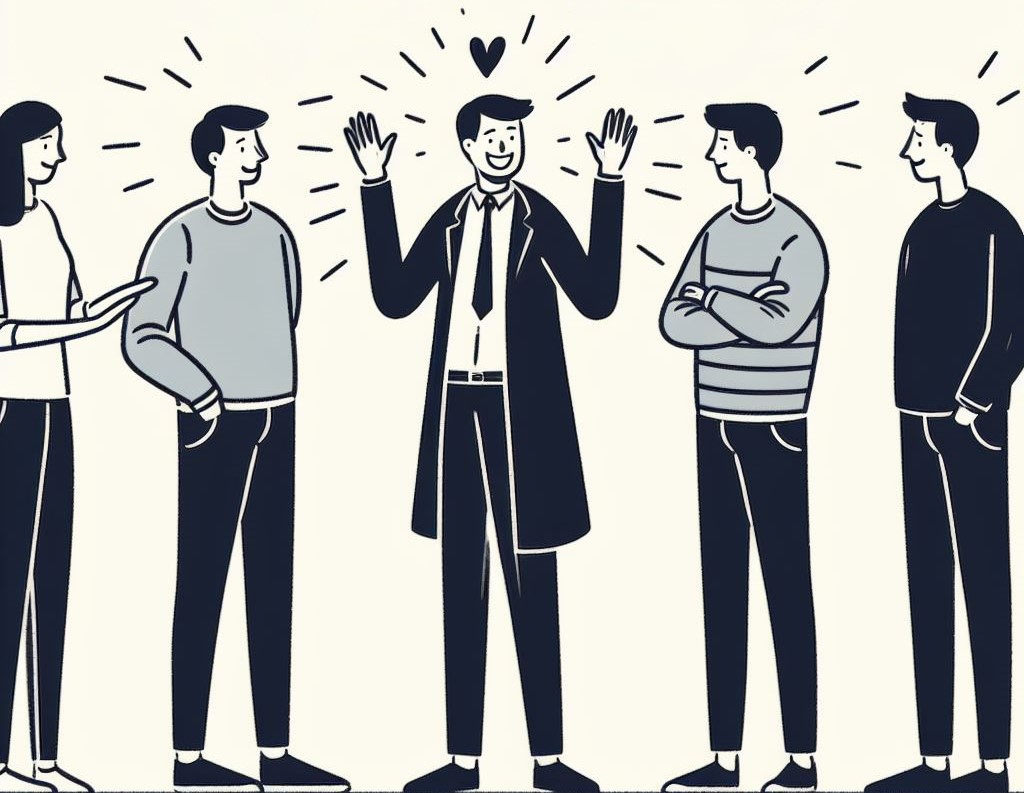
How to Convince Others Successfully: The Most Effective 6-Step Guide!
The key to convince others is in the process of understanding, connecting, and creating. Do it skillfully and you’ll never have to compromise again.
By Akash Sarkar
10th April, 2024
How do you convince others to come to an agreement with you without them feeling inferior or losing their stone-cold bent-neck self-centredness? Well, that was too much, I know.
People won’t go along with you since they already have a belief or opinion, or are simply not interested.
But here’s the thing, people have their own opinions about everything, challenging that means you’re trying to challenge their whole life’s worth of wisdom, not helpful at all!
And when it comes to selling someone something (product, service, and opinion….maybe?), most of the time, if your prospect is fresh and not necessarily familiar to you, you’ll find them not interested.
The trick here is to tell them they are, indeed, interested; they should be. They’re just not aware of it yet and the whole task to ‘Convince others’ is in fact raising that awareness.
The ability to sway others towards your viewpoint is not just an art, it’s a pivotal skill that can define the trajectory of both personal and professional endeavours.
I highly suggest you read till the end about how these ten tried-and-true methods can elevate your persuasive communication to new heights, ensuring your ideas resonate and take root in the fertile ground of open minds.
- Why Should You Learn To Convince Others?
- Understanding Who Is Listening
- Establish Credibility: Building Trus from the Start
- Confidence and Assertiveness: Owning Your Convictions
- Empathy and Connection: The Heart of Persuasion
- Language: Crafting Words That Resonate
- Timing and Persistence: The Rhythm of Persuasion
- FAQ
Why Should You Learn To Convince Others?
Why invest time in honing your persuasive skills? The answer lies in the universal human desire to be heard and understood and its struggle against the stubbornness of a personally influenced mindset.
Whether you’re advocating for a cause, trying to sell something, pitching an innovative idea, or simply navigating the complexities of everyday relationships, the power to convince others is synonymous with the power to connect and effect change.
If you’re not quick to get to people, someone else will get there. Remember, everyone everywhere is seeking attention, and the ability to convince others is going to help you, regardless of in what context you’re interacting in, win people over and in turn gain their favour.
When you go out in the wild, talk to people and make them believe you and align their views with yours, your word of mouth will gain more value, people will put more trust in you, and you’ll create a good amount of credibility for yourself.
With all this in mind, let me introduce you to the 10 methods you can utilise to convince people successfully.

1. Understanding Who Is Listening
When you ask “how to convince others?” one thing that you should understand is it isn’t a one-size-fits-all kind of process. It differs based on the message and the audience type & size.
And for starters in most cases, you need to understand your audience—their needs, fears, and aspirations. What kind of a person they are?
Or if you are going to talk to a group of people, try to understand what brought them together, it’s unlikely that people will gather without a common interest. Also, convincing a group is particularly easier than convincing someone individually.
Before you even talk about what you want to establish an agreement upon, try to figure out what it is that your listener wants to hear.
For example, when an addict is trying to search for harmfulness about consuming whatever substance they are addicted to, they are more likely to be persuaded by articles and posts that say something like “Easily Curable”, or “Mildly Harmful”. There might be 10 posts explaining the severity of the addiction but the person will be attracted by the 2 that go easy on it.
People have their predispositions. While the above example is a bit extreme, it is not far from reality and neither a disadvantage to persuasion. Even if you have an opinion polar opposite to what they believe, you can still use their own inclination towards a particular point of view to bring them where you stand.
And it all depends on how well you understand what your listener wants to hear.
2. Establish Credibility: Building Trust from the Start
When you aim to convince others, credibility is your secret weapon. Imagine stepping into a negotiation room or presenting your ideas to a group. How do you establish trust?
Say, you know what your listener/listeners are interested in hearing, you have carved the right message and designed the perfect way to deliver it. But remember, an open ear doesn’t often mean an open mind.
You want them to ‘actively’ listen to you. You want them to come voluntarily and not you dragging them. This can only happen when you have the credibility to talk about what they are interested in. Knowing what to talk about is good, but if you’re not the right person to talk about it, it won’t do the magic.
When someone like MBA Chaiwala talks about struggle and success it is more credible than when someone like Ananya Pandey does, regardless of what struggle Ananya Pandey might have gone through.
Because an audience, largely based on middle-class background or below, can not relate themselves to those who are nurtured on a silver platter talking about life struggles, the grounds are too far apart.
Aristotle’s Rhetoric talks at length about this. It goes deeper into how great orators use historical events and great names to elevate the credibility of their messages.
You can become credible before or during delivering your message, sometimes people start to trust you and start listening to you actively during the conversation once you hit that “wow, really? That’s good information!” button in their heads.
Provide Evidence, and back up your claims with data, case studies, or testimonials. People are more likely to be convinced when they see concrete proof.
Share Your Expertise, begin by highlighting your relevant experience. Whether it’s your professional background, research, or personal achievements, let your audience know why they should listen to you.
Be Transparent, honesty builds credibility. If you’re aware of limitations or potential challenges, acknowledge them upfront.

3. Confidence and Assertiveness: Owning Your Convictions
Confidence isn’t about arrogance; it’s about conviction. When you speak with authority, others take notice. If you exude any visible form of vulnerability, the listener will start to lose their excitement over what you have to say. That goes without saying right? How can you convince others when you are not even confident in yourself?
Conversely, if you emit an impression that shows you know what you are talking about and that you know it is 100% the right thing, you’re going to gain their attention.
One effective trick that you can use is, pick some counter-arguments, some basic arguments that are against what you are pitching for – or if you are trying to sell a product or service, pick some widely stated disadvantages or pitfalls of that product or service – and prove that those arguments, pitfalls wrong and non-effective for your opinion, product, service.
You can also exude confidence through your Body Language. Stand tall, maintain eye contact, and avoid fidgeting. Your posture speaks volumes. Speak clearly, enunciate your words, and avoid hesitations.
Own Your Ideas, and don’t apologize for your viewpoint, that’s the last thing you would want to do when trying to win people over. Instead, express it assertively and explain why you are right with relevant examples and scenarios.

4. Empathy and Connection: The Heart of Persuasion
Once you understand what your audience wants to hear, you are halfway there to build a strong bond between you and your listener, but that’s just halfway, you’ve still got some job to do.
Making sure you are connecting well with your prospects is important because then you are giving them an added reason to trust you.
This is empathy, it bridges the gaps and fosters understanding between you and your listener. When you genuinely connect, your message resonates and sounds more relatable.
If you are trying to convince others, try to use their anger, happiness or sadness, and amplify it. Do some homework about your audience and in your delivery of the message amplify what makes them happy, sad or angry, and point out facts of their current beliefs that evoke those feelings.
If it is anger or sadness you’re talking about, point out as much as possible and then provide your beliefs and how they are not as bad as to evoke sadness or anger.
If it is happiness, try to point out less, and provide reasons for how you deliver greater happiness.
For example, “I understand you get to save money by not ordering food online, But is it worth that you go through the traffic, horns, busy people not caring even if they hit you accidentally, then reach the hotel, struggle to place an order with a below average treatment? Is it worth more than the doorstep delivery we provide with the priority to provide special treatment to our customers?”

5. Language: Crafting Words That Resonate
Words hold immense power. Choose them wisely. When crafting the message, you need to understand what different sentences – questions, exclamations, one-liners etc. – do to the overall oratory. You need to understand when and how to use them.
Questions, for instance, are better at the beginning or at the end of a speech. When beginning with a question, you are giving your listener anticipation, a space to think and then await a revelation. This makes sure that the receiver of the message is voluntarily participating in the discussion and is willing to pay full attention to what you have to say.
And when ending or closing a speech with a question, you are making sure that you are making sure that they are not getting cut off from the conversation and are still engaged before you start another section of your speech. Invoke Curiosity, use phrases that pique interest.
Exclamatory sentences are those which you use to show extreme feelings, these are the sentences you should use when trying to empathise with the listener and amplify certain feelings.
When you’re trying to convince others, it’s good to ‘watch your mouth’. It’s important to know what to say and even more important is to know what not to say. Bluntly asking for agreement, and directly negating their point of view are two of the biggest no-no for persuasion.

6. Timing and Persistence: The Rhythm of Persuasion
The art of persuasion is as much about ‘when’ as it is about ‘what’. Now, meetings and seminars are different cases, but when it comes to an individual level – like if you are approaching someone for a proposal of some sort – it is recommended that you watch the clock.
Make sure your prospect is not preoccupied or just got off from a stressful session of work etc.. It’s enough that you understand when not to approach because any time other than that is a green signal unless you are dumb enough to call during dinner or bedtime, don’t do that.
And when it comes to meetings and seminars or any form of communication to a group or larger audience, timing is about how effectively you use the given time you have for the meeting. A general rule of thumb here is to use 60-70% of the time to nurture the audience and 40-30% of the time to actually approach them to form an agreement.
Don’t go through your entire session boasting goodies about your point of view, instead tell them what they are getting and how they deserve more, and at the last 40-30% of the session time tell them about how you can provide that value.
Be patiently persistent, and reiterate your points without overwhelming your audience.
A slow and steady approach can be more effective. Go slow when you are aiming to convince others. Build your case gradually, and lay out your argument piece by piece. Allow time for reflection, give your audience a moment to ponder your points.
Conclusion
Mastering the art of persuasion is about aligning your communication with the needs and expectations of your audience while remaining genuine and steadfast in your approach.
By employing these methods, you’ll not only convince others but also forge lasting connections built on mutual understanding and respect.
In conclusion, these methods, when applied thoughtfully and consistently, can significantly bolster your ability to communicate persuasively. Whether you’re aiming to convince a colleague, win over a client, or simply share your perspective, these strategies provide a robust framework for effective communication.
Remember, the key to convince others lies not just in what you say, but in how, when, and why you say it. By integrating these techniques into your repertoire, you’ll be well-equipped to navigate the nuances of persuasion and influence.
FAQ
Speak slowly, and keep the words simple and direct. Most of the time improper inference leads to disagreement, try your best so that the listener infers the meaning you are trying to convey.
Yes, basing your argument on experience can be very effective, it builds credibility. But the experience should be relevant.
There are many wrong times and no definite right time. You approach someone when the circumstances are in your favor.
It’s a double-edged sword if done skillfully you’ll boost the positivity of your relation with your listener and if done poorly, you’ll probably be judged as a fake.
Since they do not already agree with you, learn about their Objections and the Logical and Emotional reasons behind those objections.
Well, if you’re a prime minister, superstar or magician who came personally to persuade, why not? But if you’re not, you have to go through a process that requires skill and patience.
Read more from Communications
